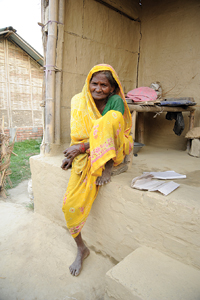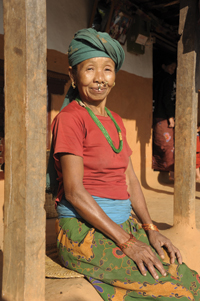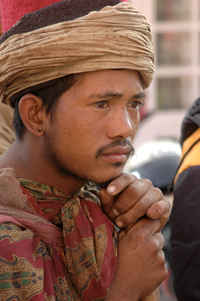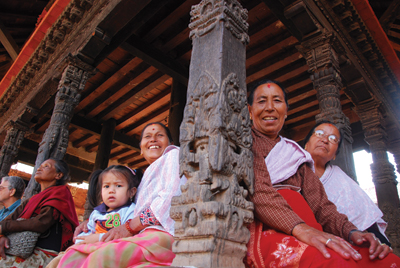October 2011http://ecs.com.np/feature_detail.php?f_id=501
 Maithili
- Language of Mithila
Maithili
- Language of Mithila
The Nepal Census 2001 showed that Maithili was the native language of 2.79 million Nepalis residing mainly in the southeastern parts of Nepal’s Terai, primarily in Janakpur, Sagarmatha and Koshi Zones and to a lesser degree, in parts of Narayani, Lumbini and Mahakali Zones. In India, 12.18 million people speak Maithili (Indian Census 2001), predominantly in Bihar, Jharkhand and parts of West Bengal. Maithili is an Indo-Aryan language. The term Maithili comes from the ancient kingdom of Mithila (in and around present day Janakpur), the birthplace of Sita - the wife of Lord Rama of the Hindu epic Mahabharata. Poet Vidyapati is the most famous Maithili literary figure.
 Tamang
– Tibeto-Burman in origin
Tamang
– Tibeto-Burman in origin
The Tamang people predominantly occupy the districts of Sindhupalchowk, Rasuwa, Lalitpur, Dhading, Makwanpur, Nuwakot, Ramechhap, Dolakha, Chitwan and Kavreplanchowk in Nepal as well as areas of Sikkim and Darjeeling (India), Myanmar, Bhutan and Tibet. Their mother tongue is Tamang, which is Tibeto-Burman in origin. Their script is known as Sambhota, but a modified version, Tamyig, is also used. Their language comprises of five dialects i.e. eastern Tamang, northwestern Tamang, southwestern Tamang, eastern Gorkha Tamang, and western Tamang. Eastern Tamang is most widely used.
 Bajjika – an ancient
language
Bajjika – an ancient
language
Said to serve as a transition between Bhojpuri and Maithili languages of the Terai, Bajjika too is a Bihari language extensively used in Bihar. In Nepal’s Terai, it is spoken by people living in the districts of Sarlahi and Rauthat. The language has its roots in ancient times when the Vajii clan ruled the republic of Vaishali during the 6th century BC.
The numerous languages of Nepal are but
different colors that paint a more vibrant picture of modern Nepal.
The Nepal Census 2001 showed that the country
had 11 million native speakers of the Nepali language. To clarify,
Nepali, as stated here, refers to the official language of Nepal,
written in Devanagri script (common to Hindi and Sanskrit). The Nepali
language was once known as Khaskura (language of the Khas people - rice
farmers), then as Parbatiya (language of the mountain people) and as
Gorkhali (language of the Gorkhas). The word Nepali is a derivation of
Nepal Bhasa, or Newari, the language of the Newars who inhabit the
Kathmandu valley.
 Symbol of Unity
Symbol of Unity
From the time of king Prithvi Narayan Shah (1723–1775) who unified the nation, the Nepali language has been an element that binds the nation, a symbol of its unity. Its role as a unifying element is not confined to the country alone. Spoken by Nepalese the world over, it helps bring countless Nepalese on to a common platform, no matter where they are or where they are from.
 Symbol of Unity
Symbol of UnityFrom the time of king Prithvi Narayan Shah (1723–1775) who unified the nation, the Nepali language has been an element that binds the nation, a symbol of its unity. Its role as a unifying element is not confined to the country alone. Spoken by Nepalese the world over, it helps bring countless Nepalese on to a common platform, no matter where they are or where they are from.
The Indian Census 2001 shows that about 2.9
million Indians speak Nepali, mostly in the states of Sikkim, West
Bengal and Assam. It is one of India’s 23 official languages. In Bhutan,
Nepali is known as Lhotshammikha (‘southern language’ of the
Lhotshampas – as the people of Nepali origin are called there). Not too
long ago, before the expulsion of about 100,000 ‘illegal alien’ Nepalis,
almost 35% of Bhutan’s population, about 242,000 people, spoke the
language too. Myanmar is another country with a sizeable number of
Nepali speaking people and now, even Great Britain has plenty, what with
there being a virtual emigration spree of ex British Gurkha Army
families. A 2007 report in Encarta (a multimedia encyclopedia) estimated
about 32.3 million people worldwide who consider Nepali to be their
mother tongue. Bottom line, a huge number of people speak the language.
Now as far as development of Nepali literature
is concerned, authorities have neatly segregated it into five eras: the
Pre-Bhanubhakta Era (before 1814), the Bhanubhakta era (1815 – 1879),
the Motiram Era (1883 – 1919), the Pre-Revolution Era (1920 – 1950) and
the Post Revolution Era. There are no recorded works before the time of
Bhanubhakta Acharya (1814–1868), who was conferred with the title of
‘Adikabi’ meaning ‘first poet’ and who was responsible for translating
the Ramayana from Sanskrit to Nepali. It was Motiram though who brought
Bhanubhakta’s work into the limelight by having them published. Chakra
Prasad Chalise of this era wrote the then national anthem, ‘Shriman
Gambhir Nepali’.
Although there were many political restrictions,
the Pre-Revolution Era was a highly fruitful one for Nepali literature.
Some giants of the times were Lekh Nath Poudyal (‘Kabi Shiromani’ –
highest among poets), Bal Krishna Sama (considered to be the greatest
playwright of the country), Laxmi Prasad Devkota (‘Mahakabi’ – greatest
poet), Gopal Prasad Mainali (‘Adhunik Kabi’ – modern poet), Siddhi
Charan Shrestha (‘Yug Kabi’ – poet of the era), Madhav Prasad Ghimire
and Bisheswar Prasad Koirala. The Post Revolution Era too, witnessed a
continuing upsurge in literary works with many literateurs making their
mark, especially in the case of newer writers, who also enjoyed
commercial success. Additionally, Nepali writers born in other countries
(most notably Darjeeling in India) such as Parijat, Lain Singh Bangdel
and Indra Bahadur Rai, have and are still contributing substantially to
the development of Nepali literature.
A multilingual nation
Let us delve a little into the 92 other languages then, (plus one mentioned as ‘unknown’ in Census 2001) that are spoken in Nepal. Recapitulating the census figures, shows that Nepali was the mother tongue of 48.61% of the population of 22.74 million. The next one in line was Maithili, the mother tongue of 12.3% of the population, Bhojpuri was spoken by 7.53%, Tharu by 5.86%, Tamang by 5.19%, Newari by 3.63%, Magar by 3.39%, Awadhi by 2.47%, Bantawa by 1.63%, Gurung by 1.49%, Limbu by 1.47% and Bajika by 1.05%. As for the other 80 languages, a percent each spoke these languages.
Let us delve a little into the 92 other languages then, (plus one mentioned as ‘unknown’ in Census 2001) that are spoken in Nepal. Recapitulating the census figures, shows that Nepali was the mother tongue of 48.61% of the population of 22.74 million. The next one in line was Maithili, the mother tongue of 12.3% of the population, Bhojpuri was spoken by 7.53%, Tharu by 5.86%, Tamang by 5.19%, Newari by 3.63%, Magar by 3.39%, Awadhi by 2.47%, Bantawa by 1.63%, Gurung by 1.49%, Limbu by 1.47% and Bajika by 1.05%. As for the other 80 languages, a percent each spoke these languages.
This is not to say that is important than the
other, especially keeping in mind that the country is headed towards a
federal system of government in which all regions will individually have
increased importance and say. A broader picture of the languages of
Nepal divides the same number into four categories, based on origin:
Indo-Aryan, Tibeto-Burman, Mongolian, and indigenous.
 Maithili
- Language of Mithila
Maithili
- Language of MithilaThe Nepal Census 2001 showed that Maithili was the native language of 2.79 million Nepalis residing mainly in the southeastern parts of Nepal’s Terai, primarily in Janakpur, Sagarmatha and Koshi Zones and to a lesser degree, in parts of Narayani, Lumbini and Mahakali Zones. In India, 12.18 million people speak Maithili (Indian Census 2001), predominantly in Bihar, Jharkhand and parts of West Bengal. Maithili is an Indo-Aryan language. The term Maithili comes from the ancient kingdom of Mithila (in and around present day Janakpur), the birthplace of Sita - the wife of Lord Rama of the Hindu epic Mahabharata. Poet Vidyapati is the most famous Maithili literary figure.
Bhojpuri – A widely spoken language
According to Nepal Census 2001, 1.71 million people in southern Nepal, mainly in the districts of Rautahat, Bara, Parsa, Chitwan, Nawalparasi and Rupandehi Bhojpuri speak in Bhojpuri. The Indian Census of 2001 shows 33 million speakers of the dialect in India, a huge number by any account. Other than Bihar, the language is spoken in Jharkhand and the eastern part of Uttar Pradesh. Bhojpuri shares vocabulary with Sanskrit, Hindi, Urdu and other Indo-Aryan languages of northern India. Bhojpuri and several closely related languages, including Maithili and Magadhi are together known as the Bihari languages. It is the third largest Indian language spoken outside India mainly in Guyana, Suriname, Fiji, Trinidad and Tobago and Mauritius; places where many Biharis migrated during the British Raj to work in sugar plantations.
According to Nepal Census 2001, 1.71 million people in southern Nepal, mainly in the districts of Rautahat, Bara, Parsa, Chitwan, Nawalparasi and Rupandehi Bhojpuri speak in Bhojpuri. The Indian Census of 2001 shows 33 million speakers of the dialect in India, a huge number by any account. Other than Bihar, the language is spoken in Jharkhand and the eastern part of Uttar Pradesh. Bhojpuri shares vocabulary with Sanskrit, Hindi, Urdu and other Indo-Aryan languages of northern India. Bhojpuri and several closely related languages, including Maithili and Magadhi are together known as the Bihari languages. It is the third largest Indian language spoken outside India mainly in Guyana, Suriname, Fiji, Trinidad and Tobago and Mauritius; places where many Biharis migrated during the British Raj to work in sugar plantations.
Tharu – A cluster of dialects
The Tharus live in Nepal’s Terai region and in adjacent Indian states of Bihar, Uttarakhand and Uttar Pradesh. According to some anthropologists, they are believed to be direct descendents of Lord Buddha, an assumption based on the fact that the Tharu king Suddhodhana ruled over Kapilvastu in Lumbini during Buddha’s time. Tharu communities in different parts of Nepal and India have different dialects influenced by languages spoken in nearby areas. For example, in western Nepal, their dialects (Dangaura, Kathoriya and Rana being the major ones) are variants of Urdu and Awadhi of nearby Uttar Pradesh, India. Similarly, in and near central Nepal, their dialect (Chitwania) is a variant of Bhojpuri of nearby Bihar and, in eastern Nepal, the language they speak, Kochila - is a variant of Maithili.
The Tharus live in Nepal’s Terai region and in adjacent Indian states of Bihar, Uttarakhand and Uttar Pradesh. According to some anthropologists, they are believed to be direct descendents of Lord Buddha, an assumption based on the fact that the Tharu king Suddhodhana ruled over Kapilvastu in Lumbini during Buddha’s time. Tharu communities in different parts of Nepal and India have different dialects influenced by languages spoken in nearby areas. For example, in western Nepal, their dialects (Dangaura, Kathoriya and Rana being the major ones) are variants of Urdu and Awadhi of nearby Uttar Pradesh, India. Similarly, in and near central Nepal, their dialect (Chitwania) is a variant of Bhojpuri of nearby Bihar and, in eastern Nepal, the language they speak, Kochila - is a variant of Maithili.
 Tamang
– Tibeto-Burman in origin
Tamang
– Tibeto-Burman in originThe Tamang people predominantly occupy the districts of Sindhupalchowk, Rasuwa, Lalitpur, Dhading, Makwanpur, Nuwakot, Ramechhap, Dolakha, Chitwan and Kavreplanchowk in Nepal as well as areas of Sikkim and Darjeeling (India), Myanmar, Bhutan and Tibet. Their mother tongue is Tamang, which is Tibeto-Burman in origin. Their script is known as Sambhota, but a modified version, Tamyig, is also used. Their language comprises of five dialects i.e. eastern Tamang, northwestern Tamang, southwestern Tamang, eastern Gorkha Tamang, and western Tamang. Eastern Tamang is most widely used.
Nepal Bhasa - Language of the Newars
Nepal Bhasa is one of the four major (out of about 500) Sino-Tibetan languages, the other major ones being Chinese, Tibetan and Burmese. It is the oldest of this language group in South Asia with many Nepal Bhasa words found in Licchavi (c. 450 - c. 750) inscriptions. Writing in this script began during the early Malla period (9th century) and was used independently from the beginning of the 12th century. The oldest book in the language known is a book on medicine, ‘Haramekhala’ (1374 AD) which is a translated work. The ‘Gopalraj Banshawali’ (a chronicle) is the first original Nepal Bhasa book. As far as creative literature is concerned, the first story book was ‘Tantrakhyan’ (1518 AD), the first song written was ‘Walangata Simule Swambaraya’, the first one-act play was ‘Ekadashi Brata’ (1633 AD) by Sidhhi Narasingh Malla while the first drama was ‘Mooldev Shashidev’ by Jagat Prakash Malla (1645-1673 AD).
Nepal Bhasa is one of the four major (out of about 500) Sino-Tibetan languages, the other major ones being Chinese, Tibetan and Burmese. It is the oldest of this language group in South Asia with many Nepal Bhasa words found in Licchavi (c. 450 - c. 750) inscriptions. Writing in this script began during the early Malla period (9th century) and was used independently from the beginning of the 12th century. The oldest book in the language known is a book on medicine, ‘Haramekhala’ (1374 AD) which is a translated work. The ‘Gopalraj Banshawali’ (a chronicle) is the first original Nepal Bhasa book. As far as creative literature is concerned, the first story book was ‘Tantrakhyan’ (1518 AD), the first song written was ‘Walangata Simule Swambaraya’, the first one-act play was ‘Ekadashi Brata’ (1633 AD) by Sidhhi Narasingh Malla while the first drama was ‘Mooldev Shashidev’ by Jagat Prakash Malla (1645-1673 AD).
Magar Kura - Langu`age of a legendary
people
The Magar people are mostly found in Palpa, Gulmi, Arghakhanchi, Syangja, Baglung, Parbat, Myagdi, Tanahun, Gorkha, Nawalparasi and Rupandehi in the western region, Rolpa, Rukum, Dolpa, Dailekh, Jajarkot and Pyuthan in the mid-western region and Ilam, Taplejung, Dhankuta, Sunsari, Sarlahi and Okhaldhunga in the eastern region. According to historian Hamilton, the former Shah kings of Nepal were descendants of Mincha and Kancha Khan who were of Magar descent. In fact, King Prithvi Narayan Shah had supposedly even declared himself as a Magar king. The legendary Purano Gorakh Battalion consisted entirely of Magars. It was the bravery of this battalion during the epic battle with the English at Nalapani in 1814 that brought the Gurkha soldiers into the world’s limelight. Their language, Magar Kura, is divided into two groups: eastern and western. The Kham Magars of the far western districts of Bheri, Dhaulagiri, Karnali and Rapti speak the Kham Magar language. The Magars of Dolpa district speak Tarali or Kaike dialects. Magar Kura’s script is known as ‘Akha Lip’”.
The Magar people are mostly found in Palpa, Gulmi, Arghakhanchi, Syangja, Baglung, Parbat, Myagdi, Tanahun, Gorkha, Nawalparasi and Rupandehi in the western region, Rolpa, Rukum, Dolpa, Dailekh, Jajarkot and Pyuthan in the mid-western region and Ilam, Taplejung, Dhankuta, Sunsari, Sarlahi and Okhaldhunga in the eastern region. According to historian Hamilton, the former Shah kings of Nepal were descendants of Mincha and Kancha Khan who were of Magar descent. In fact, King Prithvi Narayan Shah had supposedly even declared himself as a Magar king. The legendary Purano Gorakh Battalion consisted entirely of Magars. It was the bravery of this battalion during the epic battle with the English at Nalapani in 1814 that brought the Gurkha soldiers into the world’s limelight. Their language, Magar Kura, is divided into two groups: eastern and western. The Kham Magars of the far western districts of Bheri, Dhaulagiri, Karnali and Rapti speak the Kham Magar language. The Magars of Dolpa district speak Tarali or Kaike dialects. Magar Kura’s script is known as ‘Akha Lip’”.
Awadhi – Language of ‘Oudh’
Awadhi is a member of the Indo Aryan family and written in Devanagari script. It is the major language of India’s central Uttar Pradesh (‘Oudh’ region) and in the adjoining Terai area of Nepal. It is also spoken in Fiji and Mauritius. In Nepal, Awadhi speaking people populate certain areas in Lumbini zone (Nawalparasi, Kapilvastu and Rupandehi districts), Rapti zone (Dang Deukhiri district) and Bheri zone (Banke and Bardiya districts). Some famous Hindu religious texts including ‘Hanuman Chalisa’ as well as Tulsidas’s ‘Ramcharitmanas’ are written in the Awadhi language.
Awadhi is a member of the Indo Aryan family and written in Devanagari script. It is the major language of India’s central Uttar Pradesh (‘Oudh’ region) and in the adjoining Terai area of Nepal. It is also spoken in Fiji and Mauritius. In Nepal, Awadhi speaking people populate certain areas in Lumbini zone (Nawalparasi, Kapilvastu and Rupandehi districts), Rapti zone (Dang Deukhiri district) and Bheri zone (Banke and Bardiya districts). Some famous Hindu religious texts including ‘Hanuman Chalisa’ as well as Tulsidas’s ‘Ramcharitmanas’ are written in the Awadhi language.
Bantawa – Language of the Rais
Bantawa is a Tibeto-Burman language spoken in the hills of eastern Nepal by Rai ethnic groups who live in Koshi zone (Morang, Dhankuta, Bhojpur, Sunsari, Sankhuwasawa districts), Sagarmatha zone (Khotang and Udaypur districts) and in Mechi zone (Jhapa and Panchthar districts). The people of the adjoining hill districts of India and Bhutan also speak the same language. The language is a part of the Kiranti group of languages (of which there are two dozen) and is classified into northern Bantawa (Dilpali, Rungchenbung, Yangma), southern Bantawa (Hatuwali, Hangkhim), eastern Bantawa (Dhankuta) and western Bantawa (Amchoke, Sorung, Saharaja). Famed for their bravery, many Rais serve in both national and foreign armed forces.
Bantawa is a Tibeto-Burman language spoken in the hills of eastern Nepal by Rai ethnic groups who live in Koshi zone (Morang, Dhankuta, Bhojpur, Sunsari, Sankhuwasawa districts), Sagarmatha zone (Khotang and Udaypur districts) and in Mechi zone (Jhapa and Panchthar districts). The people of the adjoining hill districts of India and Bhutan also speak the same language. The language is a part of the Kiranti group of languages (of which there are two dozen) and is classified into northern Bantawa (Dilpali, Rungchenbung, Yangma), southern Bantawa (Hatuwali, Hangkhim), eastern Bantawa (Dhankuta) and western Bantawa (Amchoke, Sorung, Saharaja). Famed for their bravery, many Rais serve in both national and foreign armed forces.
Gurung – Language of the courageous
Gurung or Tamu Kyi, is spoken by the Gurungs in two dialects, eastern and western Gurung. They live in and around the Western Development Region that includes Gandaki zone (mainly Kaski, Syangja, Dolpa, Lamjung, Tanahu, Parbat and Gorkha districts and to a lesser degree, in Manang district). Smaller numbers of Gurungs also live in Baglung, Taplejung and Sunsari districts as well as in Sikkim (India) and Bhutan. Tamu Kyi is a Tibeto-Burman language and uses the Devanagari script. The Gurungs, or Tamus are reputed for their courage and like the Rais, large numbers of their population are in the armed forces of many countries including Nepal, India, Great Britain, Brunei and Singapore. Highly sociable, the Gurung people have a rich culture.
Gurung or Tamu Kyi, is spoken by the Gurungs in two dialects, eastern and western Gurung. They live in and around the Western Development Region that includes Gandaki zone (mainly Kaski, Syangja, Dolpa, Lamjung, Tanahu, Parbat and Gorkha districts and to a lesser degree, in Manang district). Smaller numbers of Gurungs also live in Baglung, Taplejung and Sunsari districts as well as in Sikkim (India) and Bhutan. Tamu Kyi is a Tibeto-Burman language and uses the Devanagari script. The Gurungs, or Tamus are reputed for their courage and like the Rais, large numbers of their population are in the armed forces of many countries including Nepal, India, Great Britain, Brunei and Singapore. Highly sociable, the Gurung people have a rich culture.
Limbu – Language of the Yakthumbas
The Limbus live in the eastern hills, primarily in Koshi zone (Dhankuta, Sankhuwasabha, Terhathum, Dhankuta, and Morang districts) and in Mechi Zone (Taplejung, Panchthar, Ilam, and Jhapa districts). They refer to themselves as Yakthumbas and their language is known as Yakthungpan. It is one of the two dozen Kiranti languages and has four main dialects: Panchthare, Phedape, Chatthare and Taplejunge, the first being the standard dialect which is also spoken in Sikkim and Darjeeling of India as well as in parts of Bhutan. Its script is a combination of Tibetan and Devnagari and is known as Sirijangga. Limbu writings dating back to the 1850’s have been found in Darjeeling, India. The Limbus have established their reputation as fierce warriors in many wars worldwide in the service of many armies.
The Limbus live in the eastern hills, primarily in Koshi zone (Dhankuta, Sankhuwasabha, Terhathum, Dhankuta, and Morang districts) and in Mechi Zone (Taplejung, Panchthar, Ilam, and Jhapa districts). They refer to themselves as Yakthumbas and their language is known as Yakthungpan. It is one of the two dozen Kiranti languages and has four main dialects: Panchthare, Phedape, Chatthare and Taplejunge, the first being the standard dialect which is also spoken in Sikkim and Darjeeling of India as well as in parts of Bhutan. Its script is a combination of Tibetan and Devnagari and is known as Sirijangga. Limbu writings dating back to the 1850’s have been found in Darjeeling, India. The Limbus have established their reputation as fierce warriors in many wars worldwide in the service of many armies.
 Bajjika – an ancient
language
Bajjika – an ancient
languageSaid to serve as a transition between Bhojpuri and Maithili languages of the Terai, Bajjika too is a Bihari language extensively used in Bihar. In Nepal’s Terai, it is spoken by people living in the districts of Sarlahi and Rauthat. The language has its roots in ancient times when the Vajii clan ruled the republic of Vaishali during the 6th century BC.
There you have it – a few details about the
major languages of Nepal. Nepal may appear small geographically, but it
has a rich and multicultural diversity. The above is but a overview of
the major languages spoken by Nepalese of approximately 102 castes and
ethnic groups of the country (Nepal Census 2011) and it is obvious that
in the new scheme of things (changes in system of national structure and
governance), the preservation of ethnic languages will be a priority to
all concerned. It is a fact that many of the languages of the country
are endangered and so, one can look forward to resurgence in this
subject as in others. One only hopes that in doing so, and in the
general spirit of new idealism, the country does not become a Tower of
Babel.
No comments:
Post a Comment